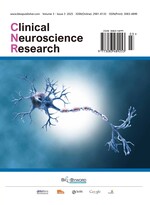Patent Foramen Ovale and Migraine: A Bibliometric and Knowledge Mapping Analysis Based on the Web of Science
Abstract
Objective: To evaluate research trends, collaborative networks, and thematic evolution in studies on patent foramen ovale (PFO) and migraine from 2005 to 2025 using bibliometric methods. Methods: The study searched the Web of Science Core Collection for 2005–2025 publications on PFO and migraine, including only English-language articles and reviews. After screening, 737 records were identified. Bibliometric analysis using VOSviewer mapped annual publication trends, co-authorship and institutional networks, co-citation patterns, and keyword co-occurrence. Results: Publication output increased overall, with an initial rise followed by a plateau (2011–2017) and renewed growth after 2018. The United States, Europe, and China were the leading contributors, forming a global network. Top institutions and prolific authors led the co-authorship network, and publications spanned cardiology and neurology journals, reflecting the field’s interdisciplinary nature. Keyword co-occurrence revealed major themes (e.g., PFO closure, migraine with aura, stroke risk) spanning mechanisms to clinical management. Reference co-citation analysis highlighted foundational studies and clinical trials that established the field’s knowledge base. Conclusion: Research on the PFO-migraine connection expanded over two decades. After early growth followed by a mid-period lull (amid inconclusive trials), the field resurged after 2018 with new advances and evidence of benefit in select patients. Ongoing interdisciplinary collaboration and increasing output suggest this field will continue to grow, providing new insights for potential clinical application.
References
Zuo Y, Wang J, Gong Z, et al., 2024, Advances in the Study of the Correlation Between Patent Foramen Ovale and Migraine. Psychiatry and Clinical Psychopharmacology, 34(3): 265–271.
Silalahi TDA, Hariyanto T, 2024, Efficacy and Safety of Patent Foramen Ovale Closure for Mitigating Migraine: A Systematic Review and Meta-analysis of Randomized Trials and Observational Studies. Therapeutic Advances in Neurological Disorders, 2024(17): 17562864241271033.
Dowson A, Mullen MJ, Peatfield R, et al., 2008, Migraine Intervention with STARFlex Technology (MIST) Trial: A Prospective, Multicenter, Double-blind, Sham-Controlled Trial to Evaluate the effectiveness of Patent Foramen Ovale Closure with STARFlex Septal Repair Implant to Resolve Refractory Migraine Headache. Circulation, 117(11): 1397–1404.
Mojadidi MK, Kumar P, Mahmoud AN, et al., 2021, Pooled Analysis of PFO Occluder Device Trials in Patients with PFO and Migraine. Journal of the American College of Cardiology, 77(6): 667–676.
Zhang Y, Wang H, Liu L, 2022, Patent Foramen Ovale Closure for Treating Migraine: A Meta-Analysis. Journal of Interventional Cardiology, 2022(6456272): 1–7.
Kavinsky CJ, Szerlip M, Goldsweig AM, et al., 2022, SCAI Guidelines for the Management of Patent Foramen Ovale. Journal of the Society for Cardiovascular Angiography, 1(4): 100039.
Schwerzmann M, Nedeltchev K, Lagger F, et al., 2005, Prevalence and Size of Directly Detected Patent Foramen Ovale in Migraine with Aura. Neurology, 65(9): 1415–1418.
West BH, Noureddin N, Mamzhi Y, et al., 2018, Frequency of Patent Foramen Ovale and Migraine in Patients with Cryptogenic Stroke. Stroke, 49(5): 1123–1128.
Trabattoni D, Brambilla M, Canzano P, et al., 2022, Migraine in Patients Undergoing PFO Closure: Characterization of a Platelet-Associated Pathophysiological Mechanism: The LEARNER Study. JACC: Basic to Translational Science, 7(6): 525–540.

